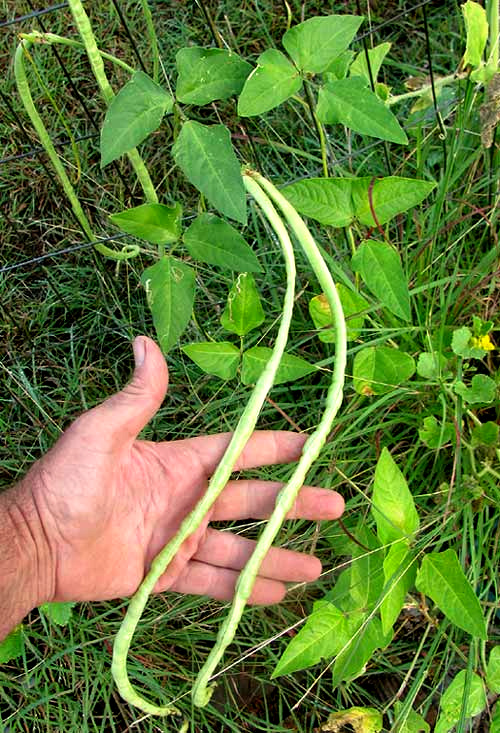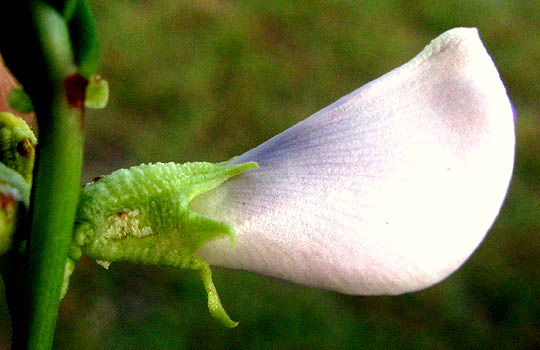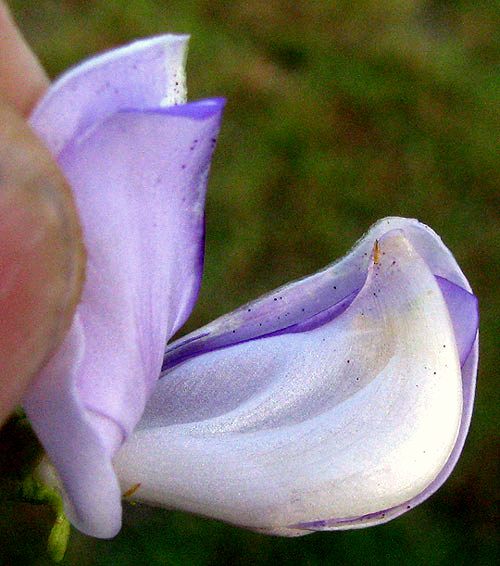Excerpts from Jim Conrad's
Naturalist Newsletter
from the July 21, 2013 Newsletter issued from the Frio Canyon Nature Education Center in the valley of the Dry Frio River in northern Uvalde County, southwestern Texas, on the southern border of the Edwards Plateau; elevation ~1750m (~5750 ft); N29.62°, W99.86°; USA
YARDLONG BEAN
My fence-climbing Yardlong Bean vines are producing, as shown below:

A close-up of a Yardlong Bean's pretty, papilionaceous flower appears below:

Yardlong Beans are VIGNA UNGUICULATA ssp. SESQUIPEDALIS, and they're known by other common names such as Asparagus Bean, Snake Bean, Chinese Long Bean, Pea Bean and Long-podded Cowpea.
Yardlong Bean's subspecies name, sesquipedalis, is Latin for "a foot and a half long," which is a more honest description of the Yardlong Bean's pods than the common name, for the legumes average not a yard long but rather about a foot and a half. The Latin "sesquipedalis," by the way, also is the root for the word "sesquipedalian," which means "tending to use long words."
Anyway, noticing that Yardlong Beans are members of the genus Vigna, and not the green bean or snap bean genus Phaseolus, we're alerted to the fact that, despite their outward similarities, Yardlong Beans aren't very closely related to green or snap beans. Last week we looked at green beans so maybe you remember that an important field mark for flowers of species in the genus Phaseolus is that the "keel" part of the blossom is coiled -- the keel being the scoop-shaped structure formed by the flower's two lower petals fusing at their common margin. Our picture of a green bean flower with its side petals, or "wings," pulled back to show the coiled keel remains at http://www.backyardnature.net/n/13/130714bp.jpg.
You can compare that with a Yardlong Bean flower with its wings pulled back to show the flower's keel below:

That keel is not at all coiled. The non-coiled keel plus some other more obscure features are significant enough to ban Yardlong Beans from the green bean genus Phaseolus, and assign them to Vigna.
The genus Vigna is worthy to know because it's also the home of mung beans, known by those who sprout beans to eat, and Azuki beans, known to certain discriminating gardeners, as well as black-eyed peas, sometimes called cowpeas. In fact, black-eyed peas are just a different subspecies of the same species that the Yardlong Bean belongs to. Black-eyed Pea plants are Vigna unguiculata ssp. unguiculata.
I first saw Yardlong Beans growing in an isolated Maya village on a mountain slope in southern Guatemala, so I've always figured that they were native to Mexico and Central America. However, genetic sequencing suggests that the wild, ancestral species' home may have been central Africa, perhaps Ghana. The Yardlong Bean subspecies, however, is a cultivar thought to have been developed in eastern Asia. Guatemala's Maya people may have received the cultivar from their Spanish conquerors 500 years ago, time enough for them to have developed their own strains.
Nutritionally, Yardlong Bean pods are regarded as very good sources for vitamin C, folate, magnesium, and manganese. 100 grams of them, providing only 47 calories, gives 23% of the daily requirement of vitamin C needed by an average person. Personally I don't see that Yardlong Beans are any more desirable than regular 'Kentucky Wonder' pole beans, except for the novelty of growing such unusual pods.